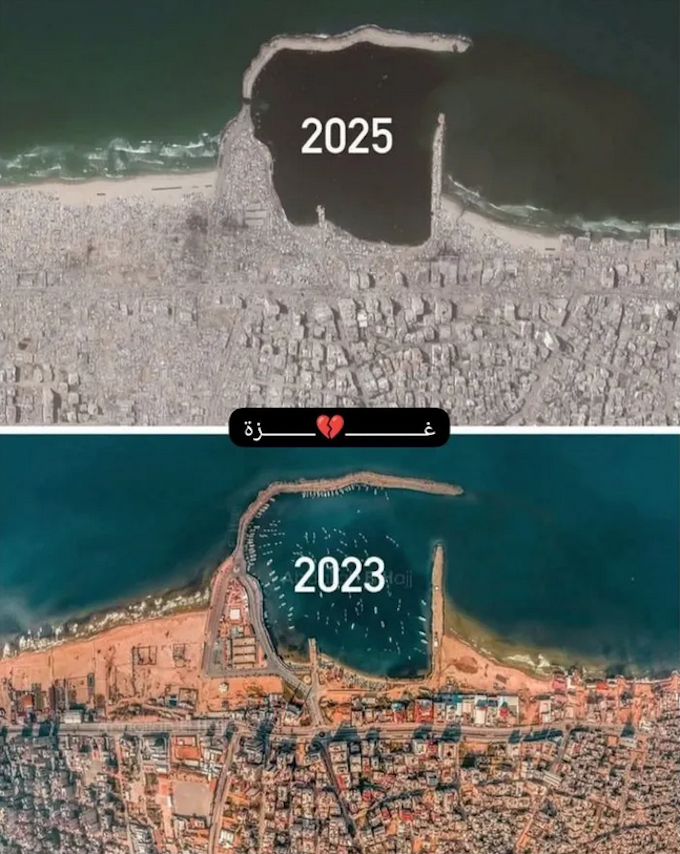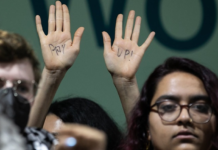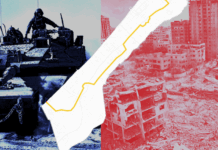
ANALYSIS: By Elijah J Magnier
Two years ago, Israel suffered what was perhaps the most jarring day in its modern history. The events of October 7, 2023, weren’t just a military failure or an intelligence lapse — they were a national humiliation. Police stations were stormed and overrun. Military posts were taken. Soldiers and officers, including from elite units, were killed or captured. The Gaza Division of the Israeli army, a symbol of Israel’s long-standing dominance over the Strip, fell into chaos.
Israel invoked the Hannibal Doctrine — a policy that allows military forces to prevent the capture of soldiers even at the cost of their lives, by opening fire on both Hamas and the kidnapped Israelis. That day, it wasn’t theory — it was execution.
In the fog of panic, Israeli fire turned on its own, and the thin line between protecting society and sacrificing civilians for strategic ends evaporated.
- READ MORE: Gaza in a thousand faces – Al Jazeera looks back at two years of Israel’s war
- Two years after October 7: Israel’s reckoning
But October 7 was just the opening act. What followed was a war unlike anything Israel had fought in fifty years — brutal, relentless, and devastating in scale and ambition. Gaza was not merely targeted; it was systematically dismantled. What began as retaliation became something else entirely: an erasure.
The illusion of military supremacy
Two years into the war, one fact is undeniable: Israel, backed by some of the most powerful military alliances in the world, has failed to conquer a territory smaller than half of New York City. 365 square kilometers — that’s all Gaza is. Yet despite overwhelming force, technological advantage, and political cover, the Israeli army has been unable to fully occupy it.
This failure is especially glaring given the scale of destruction. Over 200,000 tons of explosives have been dropped on Gaza — the equivalent of 20 nuclear bombs without radiation. That’s not metaphor. That’s the measure of how far Israel was willing to go and is not willing to stop yet: flattening entire towns, turning hospitals, schools, mosques, residential towers, universities, even cemeteries into rubble.
Gaza has endured more concentrated bombing than any territory since the Second World War.
Indeed, what Gaza has endured over the past two years dwarfs even some of the most infamous wartime bombardments of the twentieth century. In February 1945, Allied forces dropped roughly 3,900 tons of explosives on Dresden in a three-day firestorm that killed an estimated 25,000 to 35,000 people and obliterated much of the city. Where Dresden became a symbol of wartime excess, Gaza is witnessing destruction on a scale so vast it makes Dresden look like a prelude.
And unlike Dresden, Gaza’s devastation has been broadcast live, in real time, to a world that cannot claim it did not know.
But Israel was never alone and had every advantage and complicity: real-time intelligence from the United States and Britain, precision munitions from Germany, satellite targeting, drone supremacy, complete air dominance. And still, two years on, it cannot claim control over this tiny strip of land.
The problem was never firepower. It was urban warfare — a terrain where bombs are blunt tools and conquest requires something far more difficult: boots on the ground, close-quarters control, and the ability to hold territory without hemorrhaging soldiers or sparking endless insurgency.
The Israeli army, trained for dominance but not for urban occupation, found itself caught in a repetitive, grinding cycle: enter, level, retreat, repeat.
Neighborhoods were captured and declared “secured,” only to be abandoned and recontested days later. Troops rotated in and out of ruined zones, unable to maintain sustained presence. For every area leveled, resistance either moved underground or regrouped elsewhere. The war turned into a grim spectacle of destruction without achievement.
This revealed a contradiction at the heart of Israel’s military doctrine: it can destroy almost anything, but it cannot hold what it destroys. Air supremacy means nothing when the battlefield is a bombed-out maze. Gaza’s density, devastation, and defiance turned every advantage into a liability.
So while the Strip lies in ruins, it is not conquered. And that truth — buried under declarations of “strategic success” — is the defeat Israel cannot admit.
The real objective: Not security—territory
Israel’s war was not, as officially claimed, about eliminating Hamas or rescuing hostages. That narrative collapsed quickly under the weight of Israel’s own actions. From the beginning, hostage negotiations were treated as peripheral. Every time progress was made on potential ceasefires, it was Netanyahu’s office that pulled the plug — because every hostage released made the war harder to justify. Every ceasefire threatened to slow the campaign just enough for the world to ask uncomfortable questions.
This was never about hostages. It was about Gaza. More specifically: it was about removing Gaza as an obstacle to territorial ambition.
Netanyahu, cornered by political instability, corruption trials, and a fragile coalition held together by the far-right, saw in October 7 a chance to do what had always been unspoken: clear Gaza. Not of Hamas, but of Palestinians. Permanently. Not by announcement, but by attrition — bombing, starvation, siege, trauma.
Gaza’s civilian population wasn’t collateral damage. It was the target.
Destroying Gaza wasn’t a means to defeat an enemy. It was a means to reshape a demographic reality. This wasn’t defense. It was a conquest dressed up as security.
When the mask falls
In war, the first casualty is truth. But in this war, truth didn’t die quietly — it was dragged into the open, exposed by the very actors trying to hide it. Israeli soldiers live streamed brutality. Government officials made genocidal statements on public platforms. Civilian infrastructure was not accidentally struck — it was deliberately annihilated.
At first, the world made excuses. Israel had been attacked and was “entitled to defend itself”. But over time, the scale, duration, and clarity of its actions stripped away any remaining ambiguity. When every hospital (38 in total) becomes a target, when entire neighborhoods are turned to rubble, when starvation is used as a weapon — it becomes impossible to speak of “defence” without insulting reason.
And so the global tide turned. Governments hesitated, but people didn’t. From Berlin to Boston, from Sydney to Cape Town, millions marched — not for Hamas, but for the principle that no state, however victimised, has the right to massacre an entire population in response.
Israel didn’t just lose global support. It lost the moral framing that had shielded, or it had hid behind, it for decades.
It had positioned itself as a democracy surrounded by enemies. But democracies don’t bomb refugee camps, don’t livestream the deaths of children, don’t cut off water to two million people and don’t hold hostages’ lives hostage to political calculus.
Israel’s loss over the last two years hasn’t been military — it’s been existential. The myth of invincibility is broken. The image of moral exceptionalism, cultivated so carefully for decades, has shattered. Netanyahu, once a master manipulator of global opinion, now finds himself isolated, distrusted, even among allies.
What October 7 exposed was the weakness of Israel in the one arena it believed itself untouchable: control. It wasn’t just a border breach. It was a rupture of the entire apparatus that had kept Gaza contained for years. Fences, drones, AI, intelligence, surveillance — all of it failed.
And when the mask of control slipped, the response wasn’t strategic — it was criminally vengeful. It was rage mixed with blood thirst. But rage isn’t a strategy, rage destroys. And over two years, rage has destroyed Gaza — and with it, Israel’s future.
Netanyahu’s calculus: Eternal war
The war served Netanyahu well—at least at first. It silenced his critics. It unified a fractured public. It postponed trials. It gave him relevance again. But the deeper logic was more disturbing: war is the only environment where his political survival is guaranteed.
Peace, by contrast, is a threat. Peace requires compromise. Peace requires vision. Netanyahu offers neither.
Each time a ceasefire neared, his government collapsed it. Each time hostages were close to freedom, the process was torpedoed. To free the hostages would be to end the war. To end the war would be to lose power. This is the twisted loop that has defined Israel’s leadership for two years. Hostages weren’t bargaining chips — they were leverage. They were the excuse for ongoing brutality.
And the world saw it. Every broken deal, every last-minute sabotage, made it harder to pretend this was about security. By the end of the second year, no serious government believed Netanyahu was acting in good faith. Even allies began to distance themselves, not out of principle — but out of shame. What’s remarkable isn’t that Israel committed war crimes — it’s that it did so while assuming the world would look away.
For decades, that assumption held. But this time was different.
Technology turned every phone into a witness. Every child pulled from rubble was broadcast in real time. Every lie was challenged within seconds. The world saw the crimes as they happened — and watched as Israel confirmed them with its own footage.
No state can withstand that level of exposure and retain legitimacy.
Even in the US, the last bastion of unconditional support, the consensus cracked. Young people rejected the old narratives. Jewish voices joined Palestinian ones. The streets filled with dissent, not just from the fringe but from the center. Israel’s status as a protected partner is no longer guaranteed.
In Europe, traditional guilt-driven loyalty gave way to disgust. Governments clung to old alliances, but the public broke ranks. Supporting Israel was no longer an expression of Western solidarity — it became a political liability.
Ceasefire, but not peace
Now, with pressure mounting, ceasefire talks are back — this time in Egypt, under the bizarre influence of Donald Trump, whose re-entry into international politics has added a surreal dimension to an already surreal conflict. But few believe the talks will produce anything lasting. Netanyahu has built his power on conflict. He has no incentive to end it.
Even if a deal is signed, it’s unlikely to hold. The machinery of occupation, the logic of dispossession, the appetite for dominance — it remains intact. This war may pause. But the ideology that fueled it still governs Israel.
And that’s the real crisis: not the bombs, not the destruction, not even the deaths — but the belief that this can go on forever.
Israel may declare victory over Hamas. It may claim strategic success in degrading enemy capabilities. But that’s not what the world sees.
What the world sees is a nation that responded to horror with horror. A nation that lost its soul in pursuit of a war it could never truly win. A nation that allowed vengeance to become policy, and policy to become annihilation.
Two years later, Gaza lies in ruins. But so does Israel’s credibility. So does the illusion of a “moral army.” So does the narrative of self-defence that once made its case persuasive to the world.
Hamas lit the match. But Israel poured the fuel, struck the steel, and claimed the fire was purification.
In the end, what remains isn’t security. It’s ash.
Elijah J Magnier is a veteran war zone correspondent and political analyst with over 35 years of experience covering the Middle East and North Africa (MENA). He specialises in real-time reporting of politics, strategic and military planning, terrorism and counter-terrorism; his strong analytical skills complement his reporting. His in-depth experience, extensive contacts and thorough political knowledge of complex political situations in Iran, Iraq, Lebanon, Libya, Sudan and Syria provide his writings with insights balancing the routine misreporting and propaganda in the Western press. He also comments on Al Jazeera.












































